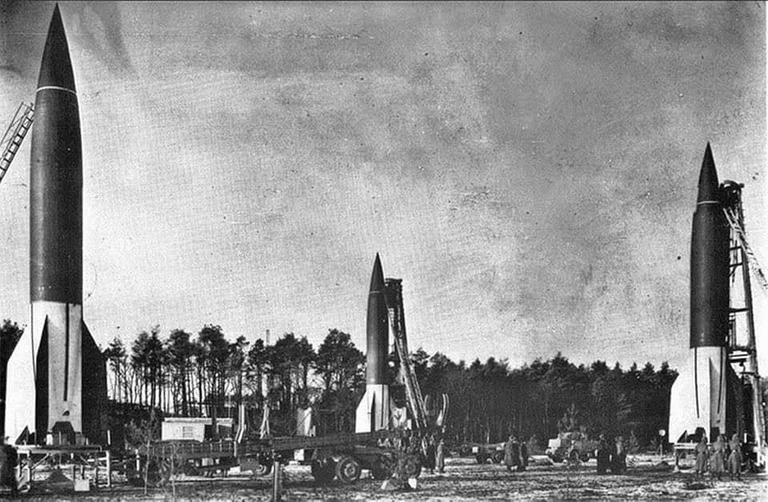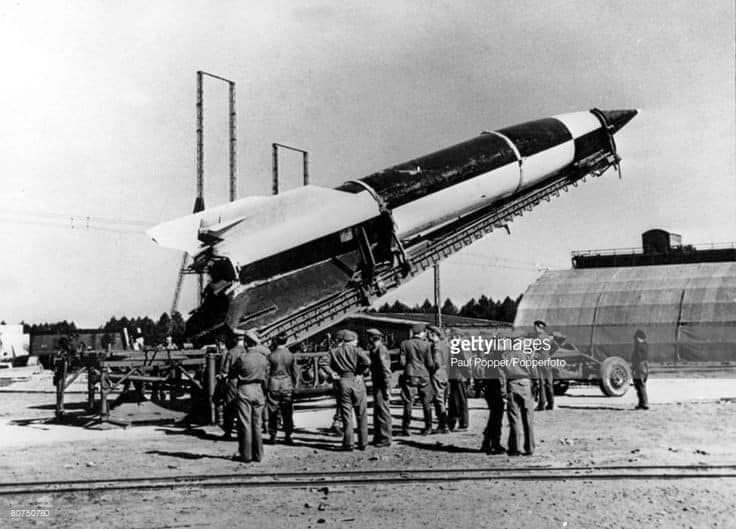Germany's V2 missiles are invincible
It seemed
On September 8, 1944, the first two German V2 rockets are fired at London. They will produce another 1,298 missiles. The Allies had no real response to these missile attacks. The bombing of Bezuidenhout on March 3, 1945 should have destroyed the missiles at Hague Boss. Nothing came of it.
GROUNDS
The direct cause of the bombing on 3 March 1945 was the shooting down of V2s at Wassenaar, Duindigt and Hagues Boss and their storage at Hagues Boss. The Spitfires still managed to shoot down the Germans' V1 (flying bomb). With the advent of the faster V2, this was no longer possible. Hence the increasing clamor in the English Parliament to disable the V2 launch and storage facilities.

At about four in the evening on September 8, 1944, the astonished inhabitants of The Hague saw two strange long shells disappearing at high speed in a north-easterly direction. There were thunderous blows and rapid machine-gun fire. An air raid, the locals thought and took cover in the shelter of the house. This was then rumored to be a V (Vergeltungswaffe) weapon. The target of the two missiles was Southwark Bridge Road fire station. However, five minutes after launch the first rocket fell with a thunderous explosion about 8 miles to its target on Staveley Road in the London suburb of Chiswick. The projectile punched a hole ten meters wide and five meters deep. Eleven houses collapsed and fifty houses were damaged. Residents and passengers were buried under the debris. Three people died and 10 others were seriously injured. The second missile landed about 18 miles below its target in Epping, northeast London. Two wooden houses were destroyed, but there were no victims.
Although official authorities anticipated the missile attack, Londoners were unaware of the impending danger. The withdrawal of launchers on French soil from 1 September had temporarily reduced V1 attacks. But on September 5, 9 more flying bombs were dropped on London. The explosion of rockets was heard across London. To avoid panic, the government initially spread the word that these were gas explosions. However, when the Germans publicly announced the V2 attack on London on 8 November, the British could not give up. Two days later, Winston Churchill told the British that long-range missiles had been fired at Great Britain.
When Hitler was cornered by the advancing Allied forces, he ordered the V2s to open fire on London on the Dutch coast in early September 1944. This was done by Lt. Gen. Dr. Sonderkommando. Sun. Kamler. In the summer of 1943 he traveled to Wassenaar where he had scouted launch sites for rocket launches. The sandy soil there was good enough to launch the V-2. In addition, The Hague is the terminus of a direct railway line with Germany. This made it easier to supply ingredients like liquid oxygen and methyl alcohol needed for missile launches.
The response from the English side was not long in coming. Reconnaissance planes that learned of the resistance took photographs to show the bombers the way. The Germans knew an air raid was coming. That is why thousands of residents of 'Neu Wassenaar' were evacuated. On September 14 at 1 p.m. At about 1.30 the evacuation was not yet complete when the first Allied bombs fell on Raaforst. This is near where the missile trucks were spotted. On September 17, eighteen bombers made a significant repeat of Raforst. As the Germans still had no access to anti-aircraft guns, the Royal Air Force (RAF) was able to operate here unhindered. Dozens of bombs landed in the forest, where they tapped wide funnels into the loose soil. Three farms and a house were destroyed at the Raforst site. There were no injuries due to voluntary and mandatory evacuation. Bombs did not fall on the locations of the V2 equipment. Additionally, the missile crew was prepared for an attack. After one or two launches, they retreated under the Terhorst canopy. There, the scattered vehicles were almost crippled.
Filled with V2 fuel before starting. In foreground cars with alcohol. Tank truck with liquid oxygen behind the rocket.
The V2 crew was very mobile. Like the flying bomb (V1) it is not tied to fixed starting points. Asphalt-like corners, or a concrete or stone road, only horn-sand soil was sufficient. The Germans preferred to take shelter in tall trees to counter the suddenness of the missile launch. They can easily push the projectile away. A large percentage of failed starts were the result of very soft soil, and rain played an important role. Just before takeoff, the missiles were filled with liquid oxygen. The liquid oxygen arrived at the Staatspur station, where it was pumped into small tanks. Small cars with icing phenomena were exhibited in The Hague for a long time.

#blurt #blurtstory #geekpranee #germany' #war #babylonian #scientists #story